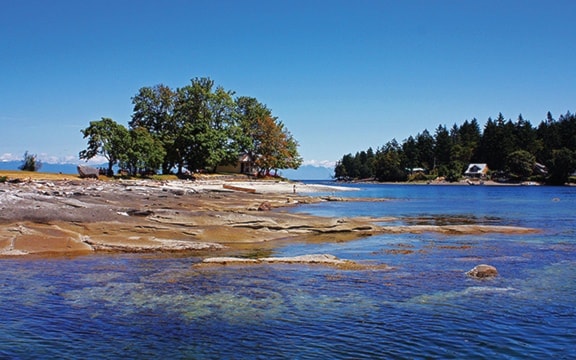For besting James Dunsmuir in a battle of wills, Elizabeth Fiddick won local immortality!
This Sunday when I lead the last Black Track Tour of South Wellington area - this one to accommodate those who
were unable to participate or had to be turned away from last month's "last" tour - we'll again visit Fiddick's Junction.
You have to know where to look for this "station" on the EN Railway, as it's listed in the B.C. Gazetteer, as a signboard does not a station make. There is a unique feature to Fiddick's, though, the vestiges of the underpass by which the Pacific Coast Coal Mines Co., later the Fiddicks, shipped their coal via their own railway to six-miledistant Boat Harbour. You can still see the deep cut in the rocks through which this forgotten colliery railway made its leisurely way to tidewater.
How did Fiddick's Junction, which sounds like a 1960s sitcom, get its name? Well, to begin with, with Cornish-born patriarch Sam Fiddick who arrived in Nanaimo in 1854 after crossing the Atlantic by windjammer, the Isthmus of Panama on foot (there being no canal) and the Gulf of Georgia by canoe. Which tells us something of this pioneer's character and determination.
With two partners Fiddick, who'd been a tin miner in the Old Country, and who'd served in the Royal Navy, found work on Newcastle Island as a contract coal miner for the Hudson's Bay Co. Until the Cariboo gold rush beckoned when he and fellow miner John Bryant, whom he'd known in Cornwall, partnered to try their luck. (Sam had previously prospected in California despite a permanent leg injury suffered while in the navy.)
Antler Creek proved a failure, as did Burns and Nelson Creeks. By winter, Fiddick had had enough and returned to mining coal in Nanaimo, leaving Bryant to seek (and find) his fortune alone. Fiddick struck it rich, too, so to speak, by winning the heart of Elizabeth Grandam. Visiting from Tynemouth, Northumberland, she married Sam on April 4, 1863. Six of their 10 children - Adoris, Charles, Alice, Samuel (the first), Samuel (the second) and Elizabeth Maude - were born in their Chapel Street home behind the Nanaimo courthouse, the last four - the two Christophers (first and second), Richard and Harry - at the Fiddicks' Cedar "ranch."
Marriage didn't totally extinguish Sam's hankering for gold and he invested considerable work in sinking a mineshaft near Sansum Narrows. But it paid no better than his previous prospecting ventures, so it was back to family responsibilities as coal miner-farmer-father before beginning a new career as hotelier. For the grand sum (as indeed it was back then) of $8,000 the Fiddicks built Nanaimo's first "fire-proof" brick hotel. At the corner of Selby and Fitzwilliam Streets, then touted as the "healthiest portion of the city," the Occidental's there today, a third storey having been added over the years.
When Sam died in January 1900 (only three years before, at age 65, he'd participated in the Klondike gold rush), his funeral was well-attended; among his pall-bearers were his old friends John Bryant and Mayor Mark Bate. Widow Elizabeth survived him for a further 28 years. The Occidental having been sold long before this, Mrs. Fiddick invested in war bonds and mortgages and contributed to construction of Nanaimo's Socialists Hall, for which she was given the honour of laying the cornerstone.
For besting James Dunsmuir in a battle of wills, she won local immortality!
Seven children survived her passing at the age of 84, three - both Samuels and the first Christopher - having died in childhood. Most of them continued to live in Cedar and Cranberry districts. Daughters Alice and Elizabeth married and moved away, Adoris remaining in Nanaimo. As of 1975, Walter John Meyer, great-great-grandson, noted in a family history filed with the Nanaimo Community Archives, there were 296 living descendants of Sam and Elizabeth Fiddick, 61 of whom lived in the Nanaimo area, the rest throughout B.C. During the 1920s two generations of Fiddicks operated a coal mine on family property at South Wellington. It was, in a sense, second time 'round for
Richard Fiddick and his sons, the mine having previously been operated by Pacific Coast Collieries. The family had had to confirm in court that their Crown grant included mineral rights because it preceded the provincial land grant to the Dunsmuirs' EN Railway.
Because the Fiddicks and the CPR, owners of the EN, couldn't come to terms for a siding, the Fiddicks shipped their coal from their own facilities at Boat Harbour, much of it being mined from directly beneath the railway's rightof-way (a story in itself). They ceased operations in 1936.
In 1900 the EN inaugurated the Wellington-Fiddick Local to transfer Dunsmuir miners to the Extension mines. So-called Fiddick's Junction operated for only six years and only the name, an illustrious one in the greater Nanaimo area, survives.
www.twpaterson.com
